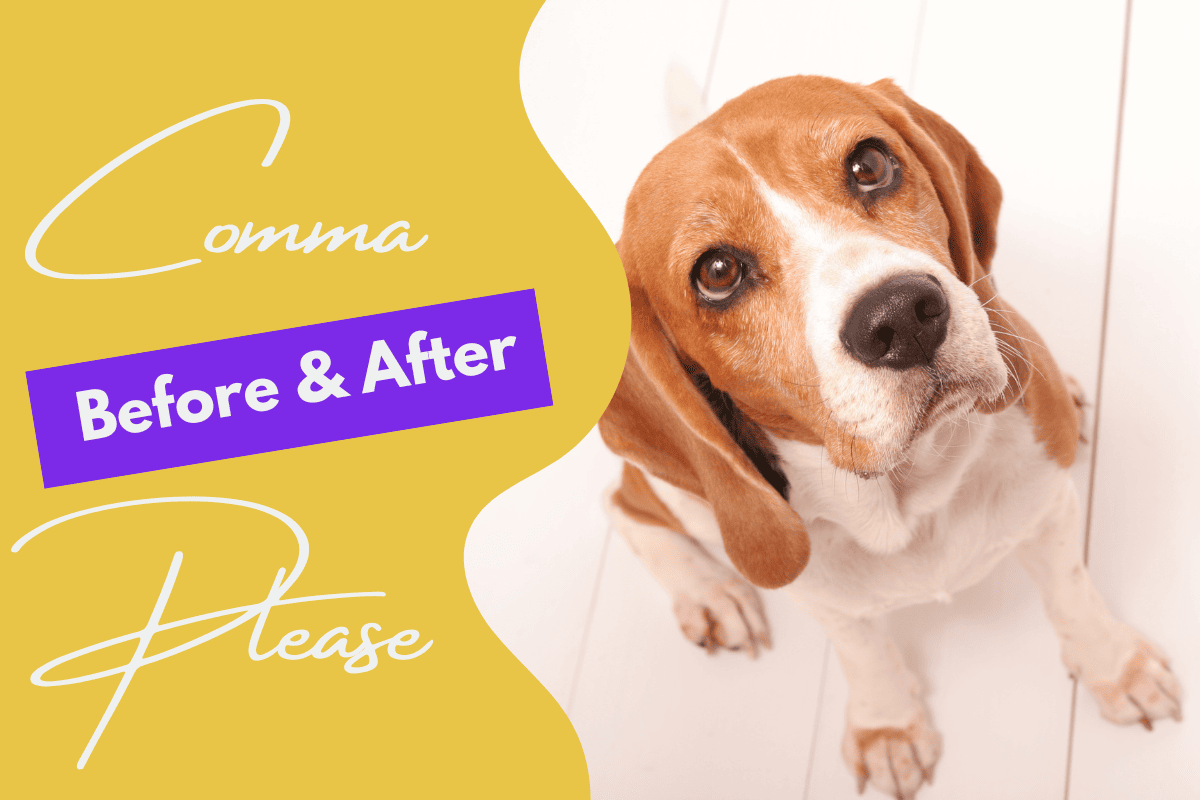Ever stared at your screen, wondering if you should put a comma before and after please?
Yeah, it’s a bit embarrassing, isn’t it?
But hey, you’re not alone. Most aspiring writers and content creators secretly feel the same frustration, thinking, “Why can’t I get this simple thing right?”
But guess what? It’s not your fault. The rules can be pretty confusing!
So, let’s dive into the world of commas and please, and together, we’ll kick that frustration to the curb. Ready to become a master of comma usage and regain your writing confidence? Let’s begin!
Table of Contents
Key Takeaways
| Position in Sentence | Function of ‘Please’ | Comma Usage |
|---|---|---|
| Beginning | Adverb or Interjection | Not typically necessary; can be used for emphasis |
| Beginning | Verb | No comma needed |
| Middle | Interjection | Depends on desired emphasis |
| Middle | Verb | No comma needed |
| Middle | Part of a Phrase | Depends on context |
| End | Adverb or Interjection | Usually preceded by a comma |
| End | Verb | No comma needed |
| Special Cases (Direct Address or Vocative) | – | Preceded by a comma |
| Special Cases (Parenthetical Interruption) | – | Set off from the rest of the sentence with commas |
| Special Cases (Following a Conjunction) | – | May be used for emphasis or to provide additional information |
Understanding Please as a Grammatical Element
When using please in a sentence, it’s important to know its various roles. In this section, we’ll explore the functions of please and how it influences comma placement. Keep in mind that a solid understanding of these basics will make it easier to master those tricky commas.
Functions of Please in a Sentence
- Adverb
As an adverb, please modifies verbs to express politeness or to make a request. For example:
- Could you please pass the salt?
- Finish your work, please.
Notice how please adds a touch of politeness to each request. It’s a subtle but powerful way to make your sentences more reader-friendly.
- Verb
When please functions as a verb, it means to give pleasure, satisfaction, or to make someone happy. For example:
- Your compliments really pleased her.
- The sunny weather pleases me.
In these examples, please is an action, not an adverb. It’s important to differentiate between the two because comma usage varies depending on the function of “please.”

- Interjection
As an interjection, please expresses a strong emotion or reaction. In this case, it’s often used to emphasize a request or appeal. For example:
- Please, don’t go!
- Just tell me the truth, please.
Here, please is not modifying a verb, but instead, it’s adding intensity to the sentiment. Recognizing this function will help you nail down the correct comma placement.
How Please Influences Comma Placement
The function of please in a sentence directly impacts whether you need to use a comma before or after it. When please acts as an adverb or interjection, commas are often necessary to separate it from other parts of the sentence. On the other hand, when please serves as a verb, commas are usually not required.
Understanding the different roles of please and their impact on comma placement is crucial for clear, effective writing. It’s all about getting the punctuation right, so your readers won’t be distracted by any mistakes. And, as you’ll see in the following sections, a deeper understanding of please will help you say goodbye to any lingering frustration.
Comma Usage with Please at the Beginning of a Sentence
As you venture into mastering commas with “please,” it’s essential to understand how their placement changes when please is at the beginning of a sentence. In this section, we’ll look at general rules, how commas can emphasize tone, and examples of correct and incorrect usage.
General Rules
When please starts a sentence, you typically don’t need a comma. This holds true whether please is functioning as an adverb or interjection. For example:
- Please hand me that book.
- Please, don’t forget to lock the door.
In both cases, a comma after please isn’t necessary. However, there are instances where you might want to use a comma for emphasis, which we’ll explore next.

Emphasizing Tone with a Comma
Sometimes, you might want to stress the urgency or importance of your request. In these cases, adding a comma after please can help convey the tone you desire. For example:
- Please, be quiet!
- Please, take your shoes off before entering.
In these instances, the comma after please adds extra weight to the request, making it clear that you’re serious about what you’re asking.
Examples of Correct and Incorrect Usage
To solidify your understanding, let’s take a look at some examples of correct and incorrect comma usage with please at the beginning of a sentence.
Correct usage:
- Please pass the sugar.
- Please, don’t touch the artwork.
Incorrect usage:
- Please, pass the sugar.
- Please don’t, touch the artwork.
In the first incorrect example, the comma after please is unnecessary and disrupts the flow of the sentence. In the second example, the comma placement is incorrect and should either be removed or placed after “please.”
By understanding the general rules for using commas with please at the beginning of a sentence and knowing when to emphasize tone, you’ll be well on your way to mastering this tricky aspect of punctuation. With practice, you’ll find that your writing becomes clearer and more effective, allowing you to connect with your readers on a deeper level.
Comma Usage with Please in the Middle of a Sentence
Navigating commas when please appears in the middle of a sentence can be tricky. In this section, we’ll explore comma usage with please as an interjection, a verb, and part of a phrase. By understanding the rules and examining examples, you’ll be able to confidently use commas in these situations.
As an Interjection
When please is used as an interjection within a sentence, comma placement depends on the emphasis you want to convey. Let’s look at how commas can emphasize tone and examine correct and incorrect usage.
Comma Placement for Emphasis
Adding commas before and after please as an interjection can stress its importance. For example:
- I need you, please, to be quiet during the meeting.
- Can you, please, take out the trash?

Examples of Correct and Incorrect Usage
Correct usage:
- She asked, please, for a moment of silence.
- Can you, please, finish your homework?
Incorrect usage:
- She asked please, for a moment of silence.
- Can you please, finish your homework?
As a Verb
When please is used as a verb, no comma is needed. Let’s examine some examples of correct and incorrect usage.
No Comma Needed
In sentences where please is a verb, you don’t need a comma. For example:
- The colors please my eyes.
- Your efforts to help please me.
Examples of Correct and Incorrect Usage
Correct usage:
- The artwork pleases me.
- Her singing pleases the audience.
Incorrect usage:
- The artwork, pleases me.
- Her singing, pleases the audience.
As Part of a Phrase
When please is part of a phrase within a sentence, comma placement depends on the context. Let’s explore different situations and review correct and incorrect usage.
Comma Placement Depending on Context
In some cases, a comma before or after please in a phrase is necessary. For example:
- If you could complete the task, that would please me greatly.
- John, please hand me the book, will you?
Examples of Correct and Incorrect Usage
Correct usage:
- I will, if it pleases you, attend the event.
- The dessert, which pleases everyone, is chocolate cake.
Incorrect usage:
- I will, if it pleases you, attend the event.
- The dessert which pleases everyone is chocolate cake.
By familiarizing yourself with the rules and examples for using commas with please in the middle of a sentence, you’ll be better equipped to tackle this aspect of punctuation. Consider the context and purpose of please in your sentence to ensure your writing remains clear and engaging.

Comma Usage with Please at the End of a Sentence
Knowing when to use commas with please at the end of a sentence can be challenging. In this section, we’ll discuss comma usage with please as an adverb, interjection, and verb. By understanding the rules and examining examples, you’ll be able to master commas in these scenarios.
As an Adverb or Interjection
When please is used as an adverb or interjection at the end of a sentence, a comma is usually required before it. Let’s dive into the rules and examples of correct and incorrect usage.
Comma Required Before Please
When please functions as an adverb or interjection, place a comma before it to separate it from the rest of the sentence. For example:
- Hand me the remote, please.
- Take out the trash, please.
Examples of Correct and Incorrect Usage
Correct usage:
- Could you pass the salt, please?
- Be quiet, please.
Incorrect usage:
- Could you pass the salt please?
- Be quiet please.

As a Verb
When please is used as a verb at the end of a sentence, no comma is needed. Let’s take a look at some examples of correct and incorrect usage.
No Comma Needed
In sentences where please is a verb, you don’t need a comma before it. For example:
- Do what will please.
- Choose the path that will please.
Examples of Correct and Incorrect Usage
Correct usage:
- Select the option that will please.
- Opt for the color that will please.
Incorrect usage:
- Select the option that will, please.
- Opt for the color that will, please.
Understanding comma usage with please at the end of a sentence is crucial for clear and effective communication. By grasping the rules for using commas with please as an adverb, interjection, and verb, you’ll be well on your way to mastering this aspect of punctuation. Keep practicing and reviewing the examples to ensure your writing remains polished and engaging.
Special Cases of Comma Usage with Please
While we’ve covered the primary instances of comma usage with “please,” there are a few special cases that might trip you up. Don’t worry—we’re here to help! In this section, we’ll discuss direct address, parenthetical interruptions, and commas following conjunctions. By reviewing these rules and examples, you’ll be equipped to tackle even the trickiest comma situations.
Direct Address or Vocative Case
When you’re addressing someone directly using their name, title, or another form of address, use a comma before please to indicate the vocative case. For example:
- Sarah, please hand me that book.
- Sir, please take a seat.
Parenthetical Interruptions
Sometimes please is used as a parenthetical interruption in a sentence, providing a polite request, or emphasizing a point. In these cases, you’ll need commas to set off please from the rest of the sentence. For example:
- I need, please, a glass of water.
- You are, please remember, responsible for your own actions.

Following a Conjunction
When please follows a conjunction like “and” or “but,” a comma may be used to emphasize a polite request or to provide additional information. For example:
- I need you to clean your room and, please, put away your laundry.
- She is an excellent cook but, please, don’t ask her to bake.
Examples of Correct and Incorrect Usage
Correct usage:
- John, please pass the butter.
- I’d like you to, please, finish the report today.
- You can go to the party and, please, remember to be home by midnight.
Incorrect usage:
- John please pass the butter.
- I’d like you to please finish the report today.
- You can go to the party and please remember to be home by midnight.
Mastering special cases of comma usage with please will elevate your writing and help you communicate more effectively. By understanding the rules for direct address, parenthetical interruptions, and conjunctions, you’ll be prepared to tackle any punctuation challenge that comes your way. Keep practicing, review these examples, and remember that with a bit of patience, you can bid farewell to comma frustration.
Consequences of Incorrect Comma Usage with Please
Let’s face it—nobody’s perfect, and making mistakes is a part of learning. Incorrect comma placement can cause confusion and misinterpretation of your intended meaning. Here’s an example to illustrate how a missing comma can change the message:
- Correct: Please, pass the salt.
- Incorrect: Please pass the salt.
In the first example, the comma makes it clear that the speaker is politely requesting the salt. In the second example, without the comma, it could be misinterpreted as a directive instead of a polite request.
The Final Piece of the Puzzle: Mastering Commas with Confidence
Hey there, you’ve made it this far, and that’s something to be proud of! We know you may still be thinking, “Will I ever get the hang of the comma before and after please?” But guess what? You’re not alone, and we’ve got your back.
Just remember, practice makes perfect. It’s time to embrace the knowledge you’ve gained from this article and apply it to your writing. By mastering the comma rules we’ve discussed, you’ll not only boost your confidence but also elevate your writing to new heights. Think about how great it’ll feel when you can write without that nagging comma doubt!
As you move forward, keep in mind that even the most accomplished writers were once in your shoes. It takes time, dedication, and patience to develop your punctuation prowess. But, with the insights you’ve gained here on comma usage with “please,” you’re well on your way to conquering frustration and becoming the writer you’ve always aspired to be.
So, take a deep breath, grab your pen (or keyboard), and tackle your next writing project with renewed determination. Remember, you’ve got this! And when you need a refresher, don’t hesitate to revisit this article. Now go forth, and let the power of the comma before and after please propel you to new writing heights!

